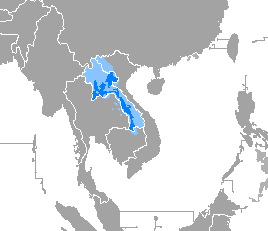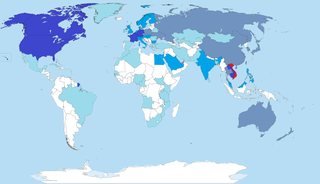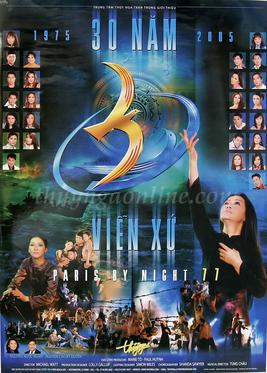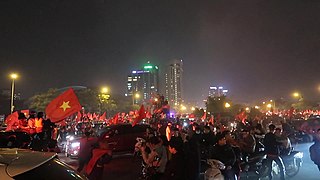Related Research Articles

Evidence for modern human presence in the northern and central highlands of Indochina, that constitute the territories of the modern Laotian nation-state dates back to the Lower Paleolithic. These earliest human migrants are Australo-Melanesians—associated with the Hoabinhian culture—and have populated the highlands and the interior, less accessible regions of Laos and all of South-east Asia to this day. The subsequent Austroasiatic and Austronesian marine migration waves affected landlocked Laos only marginally and direct Chinese and Indian cultural contact had a greater impact on the country.

The Việt Minh was a national independence coalition formed at Pác Bó by Hồ Chí Minh on 19 May 1941. Also known as the Việt Minh Front, it was created by the Indochinese Communist Party as a national united front to achieve the independence of the Democratic Republic of Vietnam.

Lao, sometimes referred to as Laotian, is a Kra–Dai language of the Lao people. It is spoken in Laos, where it is the official language for around 7 million people, as well as in northeast Thailand, where it is used by around 23 million people, usually referred to as Isan. Lao serves as a lingua franca among the citizens of Laos, who also speak approximately 90 other languages, many of which are unrelated to Lao.

Kaysone Phomvihane was the first leader of the Communist Lao People's Revolutionary Party from 1955 until his death in 1992. After the Communists seized power in the wake of the Laotian Civil War, he was the de facto leader of Laos from 1975 until his death. He served as the first Prime Minister of the Lao People's Democratic Republic from 1975 to 1991 and then as the second President from 1991 to 1992.

Overseas Vietnamese refers to Vietnamese people who live outside Vietnam. There are approximately 5 million overseas Vietnamese, the largest community of whom live in the United States.

The French protectorate of Laos was a French protectorate in Southeast Asia of what is today Laos between 1893 and 1953—with a brief interregnum as a Japanese puppet state in 1945—which constituted part of French Indochina. It was established over the Siamese vassal, the Kingdom of Luang Phrabang, following the Franco-Siamese War in 1893. It was integrated into French Indochina and in the following years further Siamese vassals, the Principality of Phuan and Kingdom of Champasak, were annexed into it in 1899 and 1904, respectively.

Paris By Night 77: 30 Năm Viễn Xứ is a Paris By Night program produced by Thúy Nga that was filmed at the Terrace Theater in the Long Beach Convention and Entertainment Center on March 5, 2005. It was released to DVD on April 28, 2005, two months later, just in time 2 days before the 30th anniversary of the Fall of Saigon on April 30, 2005.
The following is a list of political organizations and armed forces in Vietnam, since 1912:

Xépôn, is a village in the Seponh District of Savannakhet Province, Laos. It was approximately 0.65 kilometres (0.40 mi) east of the intersection of the Sepon River and the Banghiang River. It was the target of Operation Lam Son 719 in 1971, an attempt by the armed forces of South Vietnam and the United States to cut the Ho Chi Minh Trail. The village now known as Old Xépôn was destroyed. In the 1990s, gold mining began at the site, helping to create Lao's largest private industry. Expansion of mining in the area has dislocated indigenous villages around Old Xépôn.

The House of Nguyễn Phúc, also known as the House of Nguyễn Phước, was a ruling family of Vietnam. It ruled from the city of Huế in central Vietnam beginning in 1636. As the Nguyễn lords, they often fought with the Trịnh lords, who were based in Hanoi. They were overthrown by the Tây Sơn dynasty in 1776.

Kou Voravong was a Laotian politician. He was part of the anti-Japanese resistance leading group during the Second World War and after then anti-Lao Issara (ລາວອິດສລະ) in the post-war period. Throughout his career, from 1941 to 1954, he has been District Chief, Province Governor, member of the Lao National Assembly, and Royal Lao Government Minister.

Trần Ngọc Lan Khuê is a Vietnamese supermodel, judge programs and beauty queen. Lan Khuê rose to prominence in 2013 as she won the gold award in the Vietnam supermodel 2013, and became one of the most sought-after models in Vietnam. In 2014, she joined the Miss Aodai Vietnam pageant and won title. Then, she represented Vietnam in Miss World 2015 and was placed top 11. She shoot to fame when she got invited as one of 3 mentors in the reality show The Face Vietnam. Trần Ngọc Lan Khuê is the CEO of Elite Model Management and Elite Vietnam in Ho Chi Minh City, Vietnam
The Vientiane–Vũng Áng railway is a proposed 1,435 mmstandard gauge railway that ran for 555 kilometres (345 mi) between the capital of Laos, Vientiane, and port in Hà Tĩnh Province via Mụ Giạ Pass on the border between Laos and Vietnam.
Gia Thanh is a Vietnamese American master of ceremonies (MC), talk show host, game show host, writer and TV producer for Vietnamese language TV stations, newspapers in the United States. He often writes under pen names such as "Thành Công" or “Công Thành.”

The 2020 Central Vietnam floods were a series of floods in Central Vietnam, which also affected some areas in Cambodia and Laos in October and early November 2020. The floods focused heavily in several provinces including Thừa Thiên Huế, Hà Tĩnh, Quảng Bình, Quảng Trị, and Quảng Ngãi. The floods were mainly caused by the seasonal monsoon, though enhanced by numerous tropical cyclones.

Street storming is an occasional and spontaneous social activity in Vietnam. While it is also used to refer to street racing, the term is more often used to call the massive gatherings and celebrations of Vietnamese football supporters and civilians on the streets around the country in response to major victories of Vietnam football teams.

ChongLuaDao is a Vietnamese non-profit cybersecurity organization that helps clients verify the legitimacy of websites and block access to dangerous ones to keep them safe while using the internet. This non-profit project was started by a group of Vietnamese computer security specialist, including Hieu Minh Ngo, a former hacker who is now a technical expert for the National Cyber Security Centre (NCSC), Le Phuoc Hoa, Nguyen Hoang Thang, and Nguyen Hung.
References
- Dommen, Arthur J. (2001), The Indochinese Experience of the French and the Americans: Nationalism and Communism in Cambodia, Laos, and Vietnam, Indiana University Press, ISBN 9780253338549
- Lewis, M. Paul, ed. (2009), Ethnologue: Languages of the World (sixteenth ed.), Dallas: SIL International, retrieved 2012-11-30